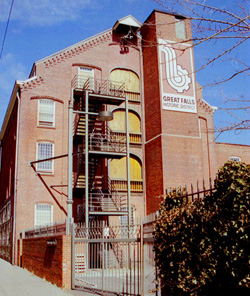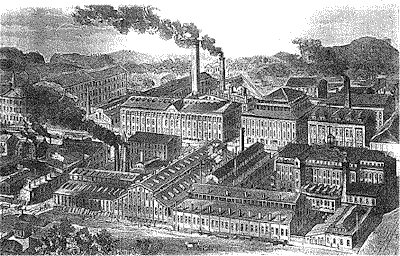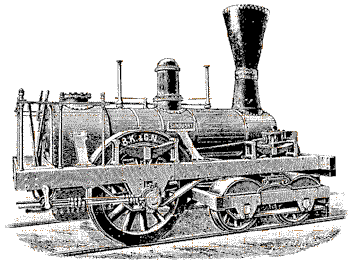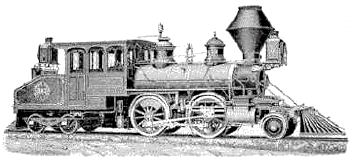
 |
 |
|
|
THE
ROGERS LOCOMOTIVE
WORKS Three locomotive manufacturing companies, the Rogers Locomotive Works, Danforth and Cooke Company, and Grant Locomotive Company were located in Paterson. Altogether, these companies produced over 10,000 steam locomotive engines. The Rogers Locomotive Works was the second largest manufacturer in the country. The No. 119 locomotive met the locomotive from the west on the Trans-Continental Railroad in the state of Utah in 1869 when the famous "Golden Spike" was driven. Excerpts
from Historic
Notes, Great Falls
Visitor Center: The first Rogers locomotive, the Sandusky, took sixteen months to complete and on October 6, 1837 made its first trip from Paterson to Jersey City and New Brunswick and back.
Rogers locomotive production rose from 1 in 1837 to 103 in 1854. By then Rogers had become America's leading locomotive company, maintaining this position for nearly ten years. After Thomas Rogers' death in 1856, the firm name was changed to the Rogers Locomotive and Machine Works with Thomas' son, Jacob A. Rogers as President. William A. Hudson was appointed Chief Engineer and Superintendent of the Works and he continued to improve the Rogers designs during the Civil War when the demand for locomotives dramatically increased. The two most famous Civil War locomotives, the 1855 Rogers General and the 1856 Danforth, Cooke Texas (which opposed each other in the great railroad chase), were both manufactured in Paterson. Until his death in 1881, Hudson continued the innovative locomotive engineering and manufacturing that became a trademark of Rogers locomotive and Machine Company. By then, a new Rogers locomotive was produced every second work day and many were shipped throughout the world.
However, in 1900, because of severe competition and poor management, the company ceased active manufacturing. In 1909, the company was sold to the American Locomotive company (ALCO) which had purchased the Cooke Locomotive Works in 1902. (ALCO was a merger and consolidation of 10 locomotive manufacturers.) The ALCO-Rogers Works which itself ceased production in September, 1923. In 1919, ownership of the Rogers Building was divided among the Dolphin Jute Mill and others and the buildings were used for jute and textile manufacturing and storage, and the Paterson Silk Exchange.
Excerpts from NPS HAER Reports The Rogers Locomotive and Machine Works is situated on what was, originally, four mill lots. These lots were first developed in the 1830s after completion of the upper raceway in 1829. The first building, known as the Jefferson Mill, was built on lot 4 in 1831. It was originally designed to be a combination of a textile machinery plant and spinning mill, but demand for machinery made use of the entire premises for that purpose more profitable. For many years, the factory manufactured only textile machinery though there was capacity for an estimated 5,000 cotton spindles in addition to the machine works. Rogers Locomotive bought the leases on lot #4 in 1859 by which time some spinning was being done in the Jefferson Mill, about 3400 spindles being in place. Rogers had assumed the lease in 1854, and had constructed some buildings for the construction of locomotives, In 1859 they bought the lease, and assumed title to the mill, and there were, at that time, some 70 people employed turning 6,000 pounds of cotton a week into yarn. 
The Erecting Shop is the oldest of the structures surviving from the complex which formed the Rogers Locomotive and Machine Works. Although all the equipment and machinery have been removed, its exterior architectural character remains intact, and includes several of the large double-bay doors through which completed locomotives were delivered. The Erecting Shop has been restored to house the offices of the Great Falls Historic Preservation and Development Corporation and the Paterson Museum. The museum features a permanent exhibit of textile machinery, Holland submarines, and Colt firearms. Special exhibits are mounted throughout the year and the museum also serves as a culture center. The eighty-ton locomotives constructed in the Erecting Shop began as small parts on the top floor and were put together in stages, each larger assembly gradually moving down toward the main floor. The completed engines then rolled through the massive wooden doors that face the street. Many Paterson steam locomotives were shipped overseas, including 144 of the 246 American locomotives used to build the Panama Canal. One of those was Old 299, which returned to Paterson in 1979 and can be seen at the rear of the Paterson Museum, at 2 Market Street. |



